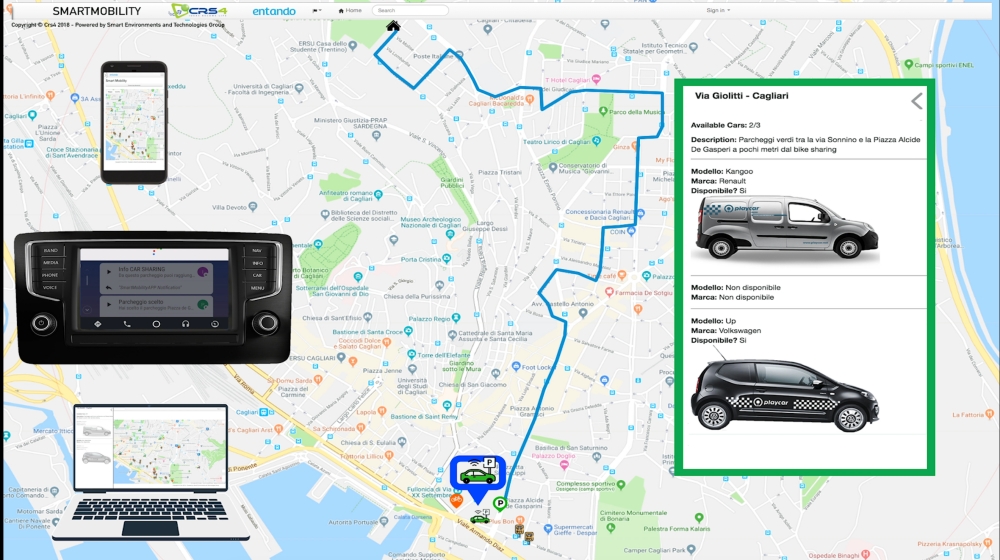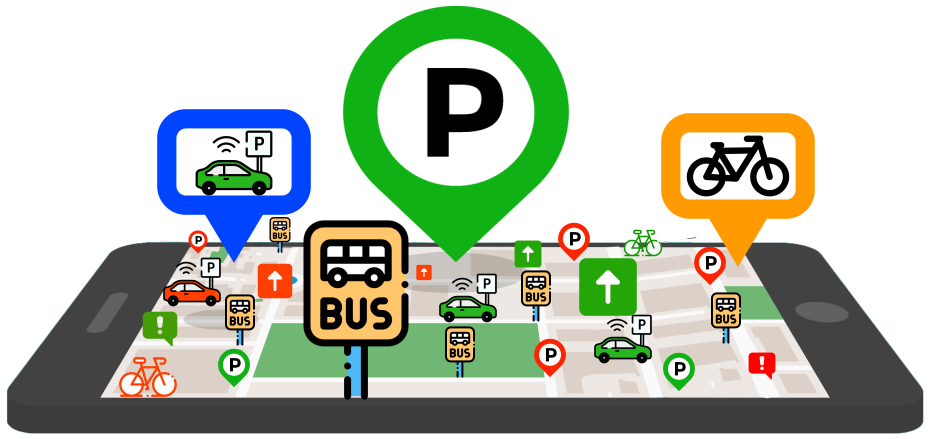Cristian Lai talks about sustainable transport applications and Internet of Things jointly developed by CRS4 and Entando
Smart mobility is the workshop held in Cagliari on June the 27th 2019. The topic requires an in-depth explanation in order not to fall into superficiality. Contextually, it is necessary to illustrate the objectives and tools clearly. We talk about it with one of the organizers, Cristian Lai, Ph.D. in Computer Science (University of Compiègne - France) and member of the CRS4's ISOC (Information SOCiety) group, since 2000, and one of the project managers of the Smart Environments and Technologies team.
Why speak about smart mobility, and what does CRS4 do in this field?
Smart mobility, Smart City, and Internet of Things (IoT) are the hot topics of this workshop. The workshop is part of the dissemination of a joint-project between CRS4 and Entando. The project is funded under the ERDF (European Regional Development Fund), PO Sardegna FESR 2007-2013, PIA 2013 (project: n.295), and is going to complete in September 2019. The overall objective is to develop a low-code, component-based Smart User Experience Platform (UXP). The platform opens the door for accelerated development besides connecting humans to a more pervasive digital world.
The development of the platform is based on the Digital Transformation (DX) paradigm, a process driven by user or customer-oriented technologies. The CRS4's commitment starts from an in-depth analysis of state of the art Internet of Things/Internet of Everything (IoT/IoE) devices, commonly referred to as smart devices. This analysis is for defining a microservices architecture. In line with the goals expected from the Entando's UXP platform, the microservices architecture allows mitigating the hardware weaknesses and limits and creating networks composed of a large number of objects. The CRS4's outcomes include a high-level architectural model suitable for integrating pervasive IoT/IoE components and a Smart City vertical application, called SmartMobility, for multimobility information urban services, using an ecosystem of IoT devices and developed using the Entando's UXP. The application provides information about park and ride facilities. Drivers are encouraged shifting from private cars to sustainable transport modes, such as bus, carsharing, and bikesharing, for part of their journey. SmartMobility aims at contributing to reducing traffic generated by private vehicles in the city besides helping drivers going towards high traffic areas by presenting real-time mobility data from different sources (video).
Other CRS4's outcomes, in terms of dissemination, are scientific papers publication. Four original manuscripts have been submitted to high-quality International Conferences. Topics encompasses multiple aspects of “Future Internet of Things and Cloud”, “Internet and Web Applications and Services”, “Software Technologies” and “Web Information Systems and Technologies”. The papers are going to be published in the conferences’ proceedings, under an ISBN, and sent to the most relevant Citation Indexes such as ISI, DBLP, Elsevier, Scopus, Google Scholar, Semantic Scholar.
During the round table on June the 27th, emerged the need for collaboration with the institutions. The public sector might contribute with data and information. Moreover, policymakers must be involved in several choices, especially concerning Information Technologies infrastructures. What do you think about the role of the Public Administration?
Worldwide re-use of information helps in better participation of citizens in the decision-making processes of their country, to enhance the transparency of public spending and political handling. The case study of the metropolitan area of Cagliari demonstrates the active participation of public administrations in everyday technology-driven life. For example, real-time traffic information is available thanks to an infrastructure of inductive-loop traffic detectors (commonly referred to as traffic sensors) that can sense vehicles passing by. These sensors are installed at the main roads connecting the suburbs to the city center. Data returned by REST APIs contain the flow of vehicles per unit of time and the average speed. This information allows estimating traffic flow at the time the user is supposed to pass to have the necessary information to elude high traffic zones. Another case is the public transport information. Most of the public transport companies in Cagliari and its extended area offer data on their bus services for free. Bus service information takes account of available bus lines, bus stops, the time-schedule, and the reliability of each line.
From a scientific point of view, based on your experience, what does move "intelligent mobility" from experimental to the applicative and commercial?
The future is already here. Intelligent mobility originates from intelligent systems designed by human beings. Artificial Intelligence (AI) is the most prominent topic contributing to smart cities and intelligent mobility. For example, systems for parking space vacancy detection can use cameras and image processing algorithms for detecting vacant and occupied parking spaces. Drivers can directly drive to the area closest to their destination. There, they will most likely find a free parking spot, avoiding in this way time and fuel wasting besides reducing traffic congestion. The automotive industry is the most prominent example of technology entering the market.
On the one hand, Advanced Driver Assistance Systems (ADAS) and autonomous vehicles, including camera-based machine vision systems, radar-based detection units, driver condition evaluation, are de-facto utilities and commodities in everyday life vehicles. On the other hand, In-Vehicle Infotainment (IVI) systems include speech recognition and gesture recognition, eye tracking and driver monitoring, virtual assistance, and natural language interfaces. The IVI provides human drivers the user experience required for pleasant driving. The recent IVI development allows “mirroring” features from a mobile phone to a car's compatible in-dash information and entertainment unit. Google Android Auto and Apple CarPlay are the primary IVI standards. Thanks to mirroring, the mobile phone's APPs are displayed and available in the vehicle, avoiding installation on the car's unit. SmatMobility is already available in Google Android Auto, getting a hands-free driving mode thanks to virtual voice assistants.
The joint-project that inspired the workshop is carried out in collaboration with a private company, Entando. What does it mean for a researcher to deal with the private sector?
This project is held thanks to the European Regional Development Fund (ERDF), a fund allocated by the European Union and transferred to Regions for investing in infrastructures and promoting regional development. It allows the Sardinia region to start attracting private sector investments besides creating jobs on its own. The synergies between CRS4 and Entando started years ago on the occasion of several collaborations. Many of the Entando's strategies are attainable thanks to the CRS4's know-how and its scientific background. Entando is a player with substantial business experience. Entando's market positioning and the way it is distinguished from the products of the competitors are interesting for CRS4. Multiple IT products and services can be jointly developed and shared with the entire regional and international network.
— A. Mameli
Technical Corner
SmartMobility is a MaaS (Mobility as a Service) application that provides information about the park and ride facilities, encouraging drivers to shift from private cars to sustainable transport modes, such as bus, carsharing and bikesharing, for part of their journey. Specifically, SmartMobility aims at contributing to reducing traffic generated by private vehicles in the city besides helping drivers in going towards high traffic areas by presenting real-time mobility information from different sources, using an ecosystem of IoT devices.
In recent years, the amount of connected devices available in everyday life has significantly grown as a crucial part of the IoT. In the IoT, the volume of devices can be remarkable. The IoT accentuates the connectivity between physical devices and data and contributes to the transportation systems supporting the smart city vision. Smart cities, mainly, are more and more enriched with sophisticated services, especially in terms of citizens’ mobility. Multimobility integrates different modalities of transportation; private car, bus, carsharing, and bikesharing. The shift towards multimodal mobility is growing in popularity, especially in urban centers, with recurring problems associated with congestion, parking, and an overall lack of space. Driving a car is essential for people because it is an opportunity for autonomy. A driver going from sparsely populated areas to a relatively big or vast city may be motivated to park the private car and use alternative transportation options. That is why their main issues are related to finding a parking slot, catching the bus on time, or choosing an appropriate alternative.
In the context of MaaS, the IoT acts as an enabler for the integration of private and public transport. Every single element of SmartMobility, i.e., parking area, bus stop, car or bike sharing station, takes part in an extremely sophisticated network of miscellaneous connected IoT devices, each one with its proprietary protocols, specifications, and characteristics. Consequently, there is a need to handle such elements, consisting of both physical (commercial instruments, custom sensor boards etc.) and logical (other web platforms, open data services etc.) devices independently.
SmartMobility is built on top of a microservice architecture specifically designed for the IoT, such as a collection of independently deployable and loosely coupled basic services. Each microservice runs its own process, communicates with lightweight mechanisms, such as HTTP resource API, and implements a definite feature. The microservice architecture used for SmartMobility is CRS4 Microservice Core for the IoT (CMC-IoT). It is able to integrate a variety of IoT devices and services. These services are composed of smaller entities, referred to as devices, which provide only a part of the service functionality and have a specific location in the city. Examples of the latter are bus stops, parking areas, and sharing stations among others. CMC-IoT extends CMC (CRS4 Microservice Core)1 and is a fork of our first open source project implementing a general-purpose microservice architecture.
Despite the conventional and business-oriented MaaS platforms, such as UbiGo and myCicero, SmartMobility neither provides any booking or payment services nor any travel planner functionality. To the best of our knowledge, no application provides information regarding parking areas occupancy. Of course, drivers may be alerted regarding empty parking places either by displays on street signs or by looking at the map on the smartphone. Nevertheless, SmartMobility focuses on parking areas providing firsthand information to the drivers looking for parking and desiring to use an alternative transportation option, park and ride facilities.
A real case study has been set up in the metropolitan area of Cagliari. Before entering the city center, the driver, using SmartMobility, can check available free parking spots in the monitored parking areas that are close to his/her position. Moreover, he or she does not have to drive around the city looking for a free parking spot. Can view real-time traffic information on the main city roads shown on SmartMobility. Once a parking lot has been identified and chosen, the user can check on the application the availability of mobility services around the parking area, such as bus stops and sharing services, and their reliability. So, he or she can choose the one most suitable as per his or her needs or walk to the final destination.







